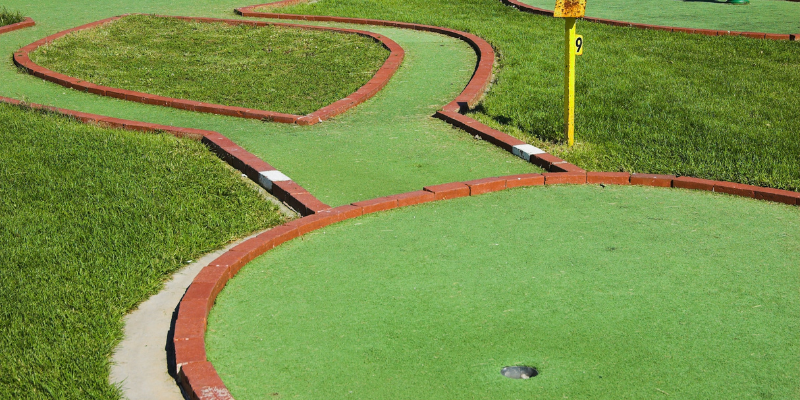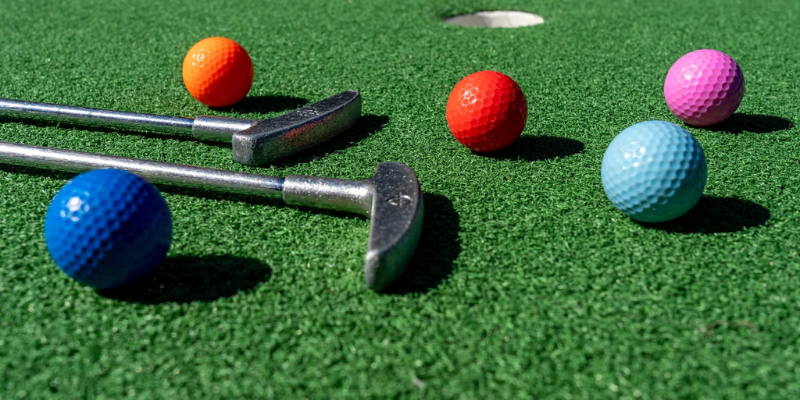Mini golf, also known as miniature golf or putt-putt, is a delightful pastime enjoyed by people of all ages. It is important to familiarise yourself with the official mini-golf rules (put put golf rules)
It’s a game that combines skill, precision, and a dash of creativity as players navigate through whimsical obstacles and tricky terrains.
While this game may seem like a casual and carefree activity, there are mini golf rules to ensure fair play and maintain the integrity of the game.
Basic Mini Golf Rules
Starting Point: Each hole begins at a designated starting point, usually marked by a tee box or a designated area. Players take turns putting from this starting point.
Order of Play: Players take turns putting, with the player farthest from the hole typically going first. After each player has taken their shot, the player whose ball is farthest from the hole putts next.

Obstacle Interference: If a player’s ball comes to rest against an obstacle such as a wall, a rock, or another player’s ball, they are allowed to reposition the ball up to one putter head length away from the obstacle.
However, if the ball is in an unplayable position, the player may choose to take a one-stroke penalty and move their ball to a playable location.
Out of Bounds: If a player’s ball goes out of bounds, beyond the designated boundaries of the hole, they incur a one-stroke penalty and must return to the spot where they last played from.
Putt putt golf rules – Scoring: The objective of mini golf is to complete each hole in as few strokes as possible.
The player with the lowest total score at the end of the round is the winner. In some variations, there may be additional rules for scoring, such as bonus points for hole-in-one shots or deducting points for exceeding a certain number of strokes.
Etiquette: Players should maintain proper etiquette on the course, such as refraining from distracting other players during their shots and allowing the player farthest from the hole to putt first.
Tips for Mastering Mini Golf
Now that you’re familiar with the rules of mini golf, let’s look at some tips to help you improve your game and conquer the putting green with confidence:
- Practice Your Putting: Spend time honing your putting skills on practice greens or at home with a putting mat. Focus on controlling the speed and direction of your shots to navigate through obstacles effectively.
- Read the Course: Before taking your shot, carefully examine the layout of each hole. Take note of obstacles, slopes, and any other features that may affect your shot. Visualize your intended path to the hole and plan your shot accordingly.
- Experiment with Different Putting Techniques: There’s no one-size-fits-all approach to putting in mini golf. Experiment with different putting techniques, such as the traditional pendulum stroke or the sidearm flick, to see which works best for you in various situations.
- Use Bank Shots Wisely: Sometimes, direct shots to the hole may be obstructed by obstacles. In such cases, strategically use bank shots off walls or obstacles to redirect your ball towards the hole. Practice these shots to improve your accuracy and consistency.
- Have Fun: Above all, remember that mini golf is a game meant to be enjoyed.
Whether you’re playing competitively or casually with friends and family, savor the moments and create lasting memories on the putting green.
Equipment for Mini Golf: Putters and Balls
When it comes to mini golf, two pieces of equipment stand out as essential for players: putters and balls. These items are the primary tools that players wield to navigate through the whimsical obstacles and tricky terrains of the mini golf course.
1. Putters
Putters are specially designed clubs used exclusively for putting in mini golf. Unlike traditional golf putters, mini golf putters are shorter in length and often feature a variety of colorful designs to enhance the fun and aesthetic appeal of the game. Here are some key aspects of mini golf putters:
- Size and Shape: Mini golf putters are typically shorter and more compact than their traditional counterparts, making them easier to wield on the miniature putting greens. They often have a simple, straight design, although some may feature unique shapes or embellishments for added flair.
- Materials: Mini golf putters are commonly made from lightweight materials such as plastic or aluminum. This construction allows for easy handling and maneuverability, perfect for players of all ages and skill levels.
- Grip: A comfortable grip is crucial for maintaining control and accuracy during putting. Mini golf putters often feature ergonomic grips made from rubber or other soft materials to provide a secure hold without causing discomfort or fatigue.

2. Balls
Mini golf balls, like putters, are specially designed for use on miniature putting greens. These balls are smaller and lighter than standard golf balls, allowing for smoother rolling and easier navigation through the course’s obstacles. Here are some key features of mini golf balls:
- Size and Weight: Mini golf balls are typically around 1.5 inches in diameter, significantly smaller than traditional golf balls. They are also lighter in weight, usually ranging from 0.5 to 0.8 ounces. This smaller size and weight make mini golf balls ideal for navigating through the compact and intricate layouts of mini golf courses.
- Construction: Mini golf balls are commonly made from durable materials such as plastic or synthetic rubber. These materials ensure longevity and resilience, allowing mini golf balls to withstand the rigors of repeated use on various types of putting surfaces.
- Color and Design: Mini golf balls come in a wide range of vibrant colors and playful designs, adding to the festive atmosphere of the game. Some mini golf balls may feature patterns, logos, or other embellishments to enhance their visual appeal and distinguish them from standard golf balls.
Conclusion
Mastering mini golf requires a blend of skill, strategy, and a touch of creativity.
By understanding official mini golf rules, players can ensure fair play and maintain the integrity of the game.
Additionally, implementing the provided tips for improving your game, along with familiarizing yourself with the equipment such as putters and balls.
Whether you’re aiming for a competitive edge or simply looking to have fun with friends and family, mini golf offers opportunities for enjoyment on the putting green.
FAQ
How does mini-golf scoring work❓
Mini-golf scoring works based on the number of strokes it takes to complete each hole, with the objective being to finish the round with the lowest total score possible.
How many times can you hit the ball in mini golf❓
In mini-golf, you can hit the ball as many times as needed to complete each hole. The goal is to finish the round with the lowest total score possible, determined by the number of strokes taken.
How do you play mini-golf turns❓
Players take turns putting the ball into the hole, with the player farthest from the hole typically going first. After each player has taken their shot, the player whose ball is farthest from the hole putts next, continuing in this order until all players have completed the hole.
Are there penalty strokes in mini golf❓
✅ Yes, penalty strokes can be incurred in golf mini for certain infractions, such as hitting the ball out of bounds or exceeding the maximum stroke limit on a particular hole. Penalty strokes add additional strokes to the player’s score for that hole.
What happens if the ball lands against an obstacle in mini-golf❓
If a player’s ball lands against an obstacle, they can move it up to one putter head length away. If it’s unplayable, they can take a one-stroke penalty to move it to a playable spot.
What is important in putt putt rules❓
In putt putt, the main goal is to hit the ball into each hole using the fewest strokes possible. Players take turns hitting the ball with a putter, aiming for accuracy, and trying to finish the course with the lowest total score.